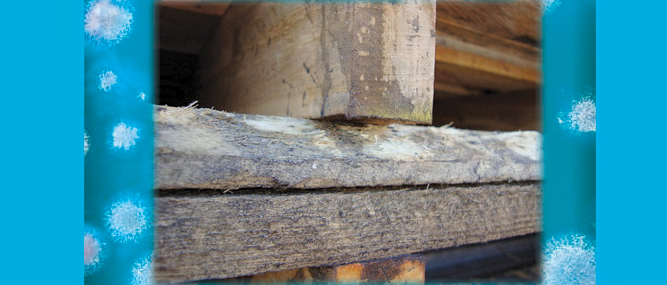Spring is finally here, and with it comes optimum conditions for mold. Mold is always prevalent, and it can occur on lumber or pallets even in the winter if they are stored in a heated warehouse, a warm trailer or container, or anywhere else where temperatures are warm enough for it to grow. However, warm weather brings the toughest time to control mold on pallets.
As part of an effective program to control mold, you must understand what the requirements are for mold to grow. It needs oxygen, food, favorable temperatures and water. If you eliminate one of the four, you will prevent mold growth. A successful mold control program will usually involve a combination of strategies aimed at eliminating or reducing multiple requirements for mold growth.
1) Oxygen — It is in the air all around us and cannot be eliminated.
2) Food — Wood provides the nutrients for mold to grow. Application of a fungicide can make the food source toxic or unavailable to the mold. Keep in mind that heat-treating pallets brings more nutrients to the surface, exacerbating the severity and types of mold.
3) Temperature — Generally, temperature cannot be controlled, as most pallets are stored in ambient conditions. Keep in mind that mold enjoys the same temperatures we do. While it can grow at temperatures as low as 32 degrees F, it grows at an accelerated rate from 66-90 degrees.
4) Water — Wood that has been dried to a moisture content below 20% will not support mold growth. However, kiln-dried lumber can quickly grow mold if it becomes wet; even if the core is below 20 percent, a wet surface can support mold growth.
The ultimate goal is to get the moisture content of the wood below 20%. If you can reach that point without mold, you are home free.
If not, you may need to dip pallets in a fungicide. While dipping in a fungicide is not a magic bullet, it can buy time to prevent mold on pallets until the wood is dry. Fungicide dips are good at preventing mold. However, they do not work nearly as well if mold already exists on wood before it is treated.
Generally, dipping pallet components in fungicide is more efficient than dipping finished pallets because a larger volume of wood can be treated more quickly. Also, in some conditions it may be difficult or impossible to use the wood before mold has already started. Spraying fungicide can work, but it is much tougher to get consistent treatment.
The length of time the fungicide will protect the wood from mold will vary depending on numerous factors, including wood species, storage conditions and strength of the fungicide. A fungicide supplier can help you determine the optimum strength for your conditions.
Other factors can have a big effect on controlling mold, and air flow is the most important. Improving air flow to aid drying — from the time the log is cut into lumber or components right up until the pallet is delivered to the customer — can have a positive effect on controlling mold.
A manager of a pallet company needs to think like a manager of a lumber drying yard. Consider spacing and the arrangement of storing lumber, components and pallets in order to maximize air flow. If material or pallets are stored in a warehouse, use fans to create air flow. We even had a customer remove siding from the wall of a warehouse to open it up and create air flow to help eliminate dampness. If the floor of the warehouse or other storage building is consistently damp or wet, you need look at ways to improve air flow.
If pallets are heat-treated, be sure to let them cool afterward before they are loaded into trailer vans. In tests, we have grown an incredible amount of mold in a short time by putting heat-treated pallets in a van while they were still hot and closing the trailer. Pallets also should be unloaded from the heat-treater immediately once the treatment cycle is finished.
Unfortunately, after pallets are delivered to your customer, the battle against mold may not be over. Educate your customers on how to store and handle pallets. You may do everything right, but your customer may not. Do not drop off trailer vans of pallets that your customer uses for storage; a closed trailer is an incubator for mold.
There is no single thing you can do to prevent mold, but there are many little things you can do that will add up to give you the desired outcome.
ISK Biocides Inc. sales reps deal with hundreds of sawmills and pallet manufacturers across the U.S., providing sapstain and mold protection for grade lumber and pallets. With about 100 years of combined experience, our sales force is well qualified to assist our customers with mold control programs.
Lance Johnson is vice president of sales & marketing for ISK Biocides. For more information or to contact, call 800-238-2523, email JohnsonL@iskbiocides.com, or visit www.iskbiocides.com.




